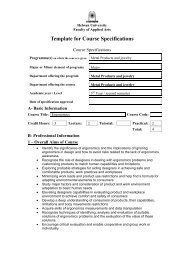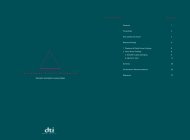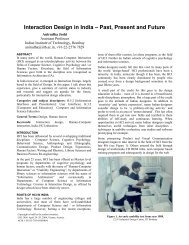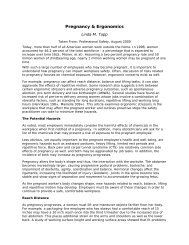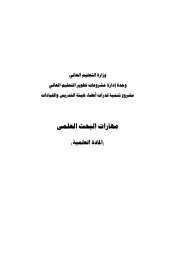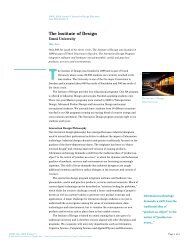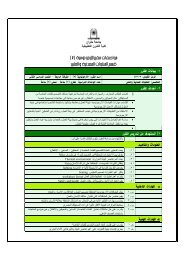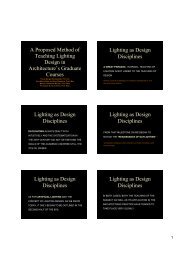• More in<strong>for</strong>m<strong>at</strong>ion about the <strong>Mobility</strong> Inclusion Unit of the Department <strong>for</strong>Transport is on the web: http://www.mobility-unit.dft.gov.uk/. In<strong>for</strong>m<strong>at</strong>ion aboutthe Disabled Persons Transport Advisory Committee can be found <strong>at</strong>http://www.dptac.gov.uk/Challenges with the ADAAG, Marsha MazzKey PointsThis present<strong>at</strong>ion provides a brief overview of key fe<strong>at</strong>ures and design challengesof the ADAAG.• The ADAAG provides minimum design requirements and is not a buildingcode. There<strong>for</strong>e, designers should <strong>at</strong>tempt to develop environments th<strong>at</strong>surpass r<strong>at</strong>her than simply meet the requirements of ADAAG.• Revisions to the ADAAG are being challenged because of a lack of neededd<strong>at</strong>a. Key issues include lowering the controls on vending machines, designissues to allow wheeled mobility users to use <strong>for</strong>ward approaches whenaccessing w<strong>at</strong>er fountains, space requirements <strong>for</strong> transfers in showerfacilities, handrail shapes, clearances and orient<strong>at</strong>ions, and the design of theappropri<strong>at</strong>e sight lines in assembly areas.General Discussion of Guidelines and StandardsAnother approach to development of guidelines involves the dissemin<strong>at</strong>ion of“Best Practices”. For example, Dave Rapson developed such a guide th<strong>at</strong>included recommend<strong>at</strong>ions <strong>for</strong> the design of environments to accommod<strong>at</strong>epowered scooters th<strong>at</strong> was developed by the Province of Manitoba and City ofWinnipeg.Although simul<strong>at</strong>ion tools are very welcome <strong>for</strong> use in comparison of standardsand help bring the results to the designer and user, their use in the developmentof standards is not yet clear. Use of such tools will require new ways to interpretthe d<strong>at</strong>a and the d<strong>at</strong>a interpret<strong>at</strong>ion is an important element of the standardsdevelopment process.The costs and benefits of guidelines and standards <strong>for</strong> space requirements arenot considered in a rigorous way across countries.The need <strong>for</strong> standardizing research methods and the way th<strong>at</strong> in<strong>for</strong>m<strong>at</strong>ion isapplied to design was emphasized.<strong>Space</strong> <strong>Requirements</strong> <strong>for</strong> <strong>Wheeled</strong> <strong>Mobility</strong> 22
Trends and Issues in TechnologiesTrends and issues in wheeled mobility technologies, RoryCooper, Ph.D., and Rosemarie Cooper, M.P.T., A.T.P.AbstractThis commissioned paper and present<strong>at</strong>ion summarized the st<strong>at</strong>e of currenttechnologies, trends and market indic<strong>at</strong>ors of wheeled mobility devices, and theirpotential impacts on the design of the built environment and transport<strong>at</strong>ionsystems. Manual wheelchairs can be c<strong>at</strong>egorized as depot, light weight, ultra-lightweight, bari<strong>at</strong>ric, standing and specialized. The depot manual chair is the mostcommon manual chair due to its low cost and high durability. Powered mobilityaids include lightweight devices <strong>for</strong> indoor use, those used <strong>for</strong> indoor and lightoutdoor use, those used <strong>for</strong> active indoor and outdoor user, powered scooters,bari<strong>at</strong>ric, standing, push rim power activ<strong>at</strong>ed (PAPAW) and specialized se<strong>at</strong>ingdevices. The market <strong>for</strong> both manual and powered bari<strong>at</strong>ric chairs is expected togrow the most rapidly of all mobility device c<strong>at</strong>egories due to the increasingprevalence of obesity in the U.S. Bari<strong>at</strong>ric chairs are generally much wider thanother types of chairs. Thus, users of this type of chair can encounter uniquebarriers in the environment. Markets <strong>for</strong> other types of chairs are also expected togrow, although not as rapidly as the bari<strong>at</strong>ric chair market. The various trends willmost likely lead to an overall increase in chair size and in space requirements.There are technological limit<strong>at</strong>ions associ<strong>at</strong>ed with the design of wheeled mobilitydevices th<strong>at</strong> require additional research and design work. Further researchshould focus on reducing risks to secondary conditions associ<strong>at</strong>ed with wheeledmobility device use, determining utiliz<strong>at</strong>ion r<strong>at</strong>es of wheelchairs in differentsettings, and new mobility aid technologies to accommod<strong>at</strong>e a gre<strong>at</strong>er range ofindividuals who need assistance such as the elderly, the obese and those withmultiple sclerosis. Research focused on improving safety during a wide range offunctional activities is also needed.Key Points• Current manual chairs range in quality, com<strong>for</strong>t, per<strong>for</strong>mance, durability andcost. Although the Center <strong>for</strong> Medicare and Medicaid Services is among thetop purchasers of wheelchairs in the U.S., its selection of wheelchairs is basedon durability, use in the home and cost, r<strong>at</strong>her than the full range of needs ofwheeled mobility aid users. There<strong>for</strong>e, it is not surprising th<strong>at</strong> depot chairs areby far the most common chair.• Only 20-25% of people worldwide who use wheeled mobility devices reportth<strong>at</strong> there mobility needs are met.• There is a high degree of variability in the turning radius and stability ofpowered wheelchairs. Those with rear-wheel drive typically have a largerturning radius, those with mid-wheel drive have a shorter turning radius but are<strong>Space</strong> <strong>Requirements</strong> <strong>for</strong> <strong>Wheeled</strong> <strong>Mobility</strong> 23



